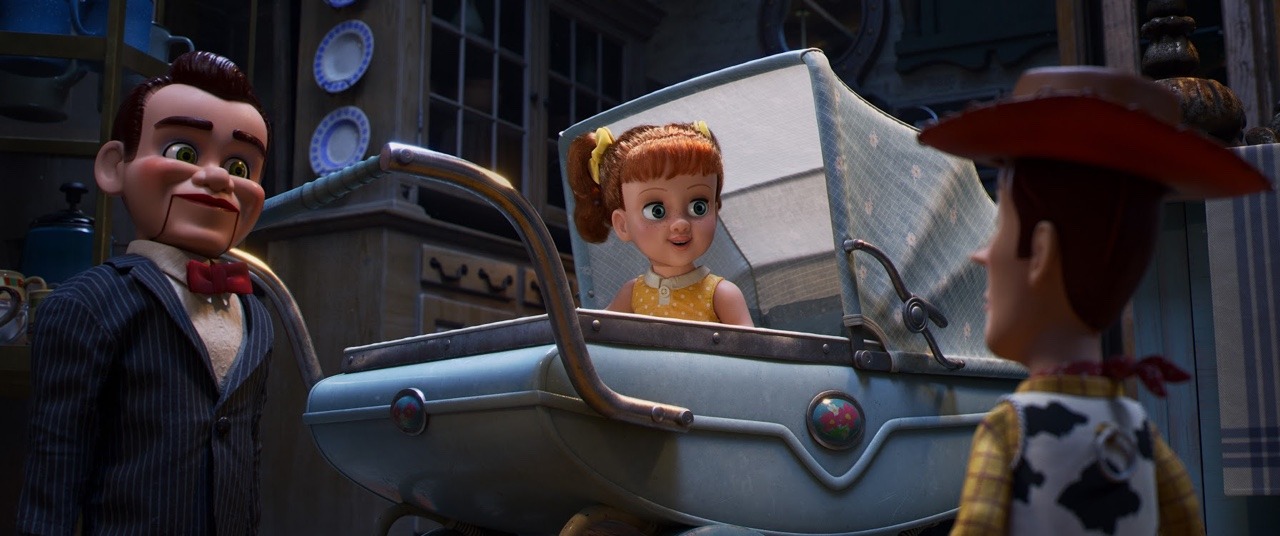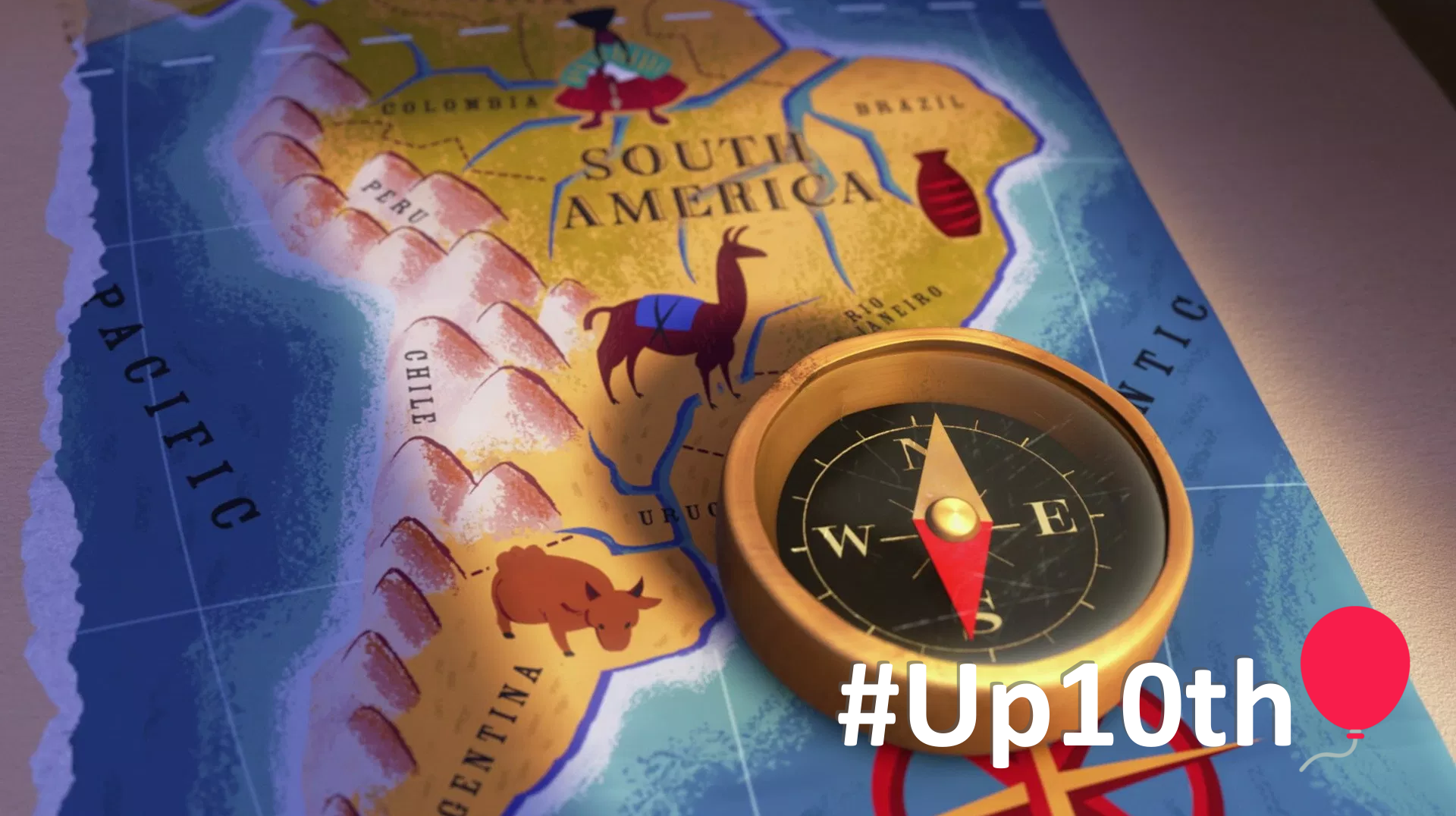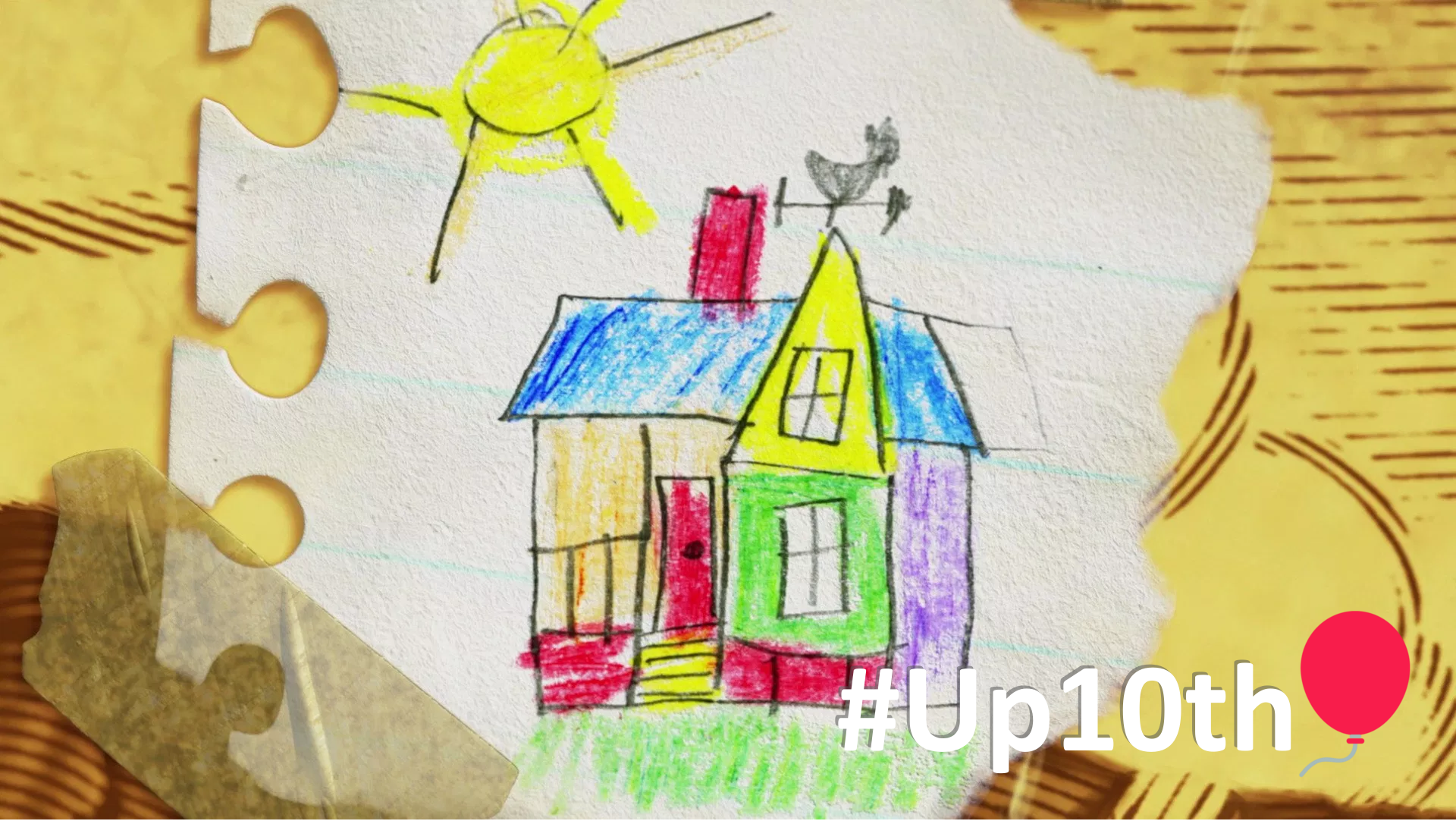Learning how Pixar movies get made is a little daunting. For anyone who doubts just how rigorous this process is for animated films, let the artists, writers, technicians, and animators lay those doubts soundly to rest! During my Pixar visit last month, I was wowed by the way a specific scene in Toy Story 4 gets made. Read on to learn more and wow yourself!
From Start to Finish: Creating a Scene in Toy Story 4
This presentation was moderated by nine people, which is still just a small portion of the crew who worked on this particular scene, Meet Gabby Gabby. Things start off even smaller with just four people: the writer, director, story supervisor (Valerie LaPointe on this film), and editor. The writer and director have a basic story and it’s LaPointe’s job to detail that story, with the concept and characters. LaPointe supervises a team of story artists, who contribute gags, character ideas, and key narrative points, in addition to drawing the film!
 Toy Story 4 (Pictured L-R): Valerie LaPointe (Story Supervisor), Axel Geddes (Editor), Thomas Jordan (Sets Supervisor), Steve Karski (Sets Supervisor), Patrick Lin (Layout Supervisor), Robert Russ (Supervising Animator), Scott Clark (Supervising Animator), Jean-Claude Kalache (Director of Photography, Lighting) & Robert Moyer at April 4, 2019 press day. Photo by Marc Flores. ©2019 Disney/Pixar. All Rights Reserved.
Toy Story 4 (Pictured L-R): Valerie LaPointe (Story Supervisor), Axel Geddes (Editor), Thomas Jordan (Sets Supervisor), Steve Karski (Sets Supervisor), Patrick Lin (Layout Supervisor), Robert Russ (Supervising Animator), Scott Clark (Supervising Animator), Jean-Claude Kalache (Director of Photography, Lighting) & Robert Moyer at April 4, 2019 press day. Photo by Marc Flores. ©2019 Disney/Pixar. All Rights Reserved.Story
There’s many steps involved in building a scene, but the first and most crucial begins with the script. Everything is written and broken down into about 30 sequences. Then the artists draw the scene. By this point, the director (Josh Cooley), writer (Stephany Folsom), story artist, and LaPointe read the script, give feedback, toss out ideas, and ask questions. With all of that material, the story artist can now visualize all of those ideas on the pages, which is called ‘thinking on paper.’ This includes shots, acting, and posing. Remember that animated films are made entirely from scratch; the actors in any given scene are the animators giving physical performances through the characters; the sets, shots and props have to be created too, all inside the computer.
“When you’re a story artist, you’re taking the first stab at everybody else’s job on the film with thinking through the entire scene.”
-Valerie LaPointe
The story artists, in a truly stunning feat, draw every frame of the shot. There’s anywhere from 100 to 300 storyboards/drawings in the sequence. These drawings get pitched digitally to the director, writer, editor, and story team, which is similar to how LaPointe presented the drawings to us in Pixar’s theater. If you’ve ever watched the special features on Pixar’s home releases, you have an idea of what these pitches involve. The drawings are displayed as the artists use sound effects and special voices to “sell the scene” they’re working on. They receive feedback and changes from the rest of the team and then it’s back to the (digital) drawing board. When those changes are complete, the scene goes to the editorial department, who are responsible for making a watchable movie.
Editorial
The folks in editorial add more sound effects, as well as scratch (temporary) voices for the characters before the actors record their lines. A reel with the drawings, sounds, and voices represents the film, which goes through lots of rewrites and drawing fixes. This process lasts one to three years, but the typical timeframe is two.
Now we are ready to meet Gabby Gabby! Some background on this scene: Woody and Forky wind up in an antique store, where they come across the vintage doll in a baby carriage. She’s out on her morning stroll with her henchman, Benson, a ventriloquist dummy. LaPointe provided the scratch voice for Gabby in this early stage, and she sounded great! Christina Hendricks voices the doll in the completed film, and that’s who I thought we were hearing at first.
Think of scene building as you would of the set design in a live action movie or TV show. The story is the set and all the props are what the editorial department add to the scene. In this case, the “props” are dialogue, sound effects, and music. Axel Geddes, who’s been editing Pixar films since Monsters, Inc. in 2001, was the sole representative from editorial for this presentation, but in reality, there’s a large team of editors and assistant editors who put the film together repeatedly. Editorial is really the center of every department as shots go through the production pipeline. A shot moves through the pipeline but it is frequently returned to editorial to make sure it contributes to the overall film.
 STORYBOARD – To create a sequence in Disney and Pixar’s “Toy Story 4,” one of the early steps in the production pipeline is building storyboards. Artists sketch the key beats in a sequence, suggesting possible set positioning, camera angles and character poses. This sequence is when Woody and Forky meet Gabby Gabby for the first time.
STORYBOARD – To create a sequence in Disney and Pixar’s “Toy Story 4,” one of the early steps in the production pipeline is building storyboards. Artists sketch the key beats in a sequence, suggesting possible set positioning, camera angles and character poses. This sequence is when Woody and Forky meet Gabby Gabby for the first time.So what’s the editing process like? Well, a stack of virtual images from the story department is sent to editorial. As previously mentioned, the reels are the film, and they contain the storyboards, which act as the foundation. The editorial team uses their temporary dialogue as building blocks for the scene which determine the performances and other aspects, like how long to hold a specific pose. And those performances are the tools to build each shot. As Geddes explained, the editorial team are the second actors for these characters; they inhabit them. Once the performances are timed out, the scene can be edited.
Animation editing is similar to live action, but editorial decisions are made on each frame rather than each shot. Live action films utilize latent production sounds, but they have to be created for animated films. Sound effects go a long way in establishing the mood and atmosphere of a scene. In Meet Gabby Gabby, the mood was eerie; the creaky wheels on the baby carriage helped with that. Music also strengthens the tone. The editors use preexisting soundtracks before Pixar’s trusted composers are brought in.
We watched Meet Gabby Gabby more than once, and it had evolved each time. Geddes said it was boring to watch the same shot multiple times (“Which is exactly what my job is like”), but I can honestly say that I didn’t find it boring at all. I not only got a glimpse into what he does, but I did it myself! Sort of. The editorial team does a lot of repetitive work, but that’s to ensure that the most compelling version of the story is being told. Variations of the film, some of them vastly different, are screened for internal audiences over a four year period. Meet Gabby Gabby was just one version of the film where the goal was to introduce a brand new villain into Toy Story’s universe.
Technical Direction
Supervising technical director Robert Moyer works closely with most of the departments to build assets and shots for the film. After meeting Gabby Gabby, we got some insight into how she was brought to life. She’s a 1957 pull string talking toy who was made around the same time as Woody. The challenge was to make her look doll like rather than human, like animators had to do with Bo Peep. There was a lot to think about: making her look as if she was made of hard plastic and not flesh, how her eyeballs sat in their sockets, the crease of baby fat, and even how her head fits into her neck. Gabby Gabby’s hair also had to look thicker and more metallic, as did the iris of her eyes, so she could appear alive.
Forky is the other challenging character. He had to be believable as something made by a child, but also appealing and consistent with the rest of the Toy Story characters. The crew made Forkys of their own in workshops to determine the basics of his design. Forky looks simple, but he’s made up of more materials than any other character.
We also got to learn about those dummies. Four of them were built, and the crew studied their internal structures which were very complex. Moyer was able to show us why the dummies move the way they do; they had to look as if they’re being supported by someone else. Essentially, everything about them had to feel slightly off, which only enhanced their creepiness.
Location, location, location (sets!)
Pixar sets are usually massive. From the ocean to outer space to the inner workings of the mind, they’ve taken us almost everywhere. In Toy Story 4, there’s the antique store, which is impressive despite its ordinariness. It’s an exciting place for a toy, because they get to stay hidden while moving around and being alive. Set supervisors Thomas Jordan and Stephen Karski walked us through the creation of the antique shop, which is 8,000 square feet and houses more than 10,000 items. A lot of those items were custom made for the movie, but some others were recycled from earlier Pixar films. This set took two years to build.
The antiques mall in the film feels like a city to a toy, not unlike boxes in a basement resembling a sprawling city to a bug! Not only did the antiques mall feel like a city, it looked like one too. The rugs in the aisles are where the customers shop, and toys avoid those. But the items are all arranged by theme and take on the appearance of a city complete with alleyways and neighborhoods.
Camera and Staging
From the sets we moved on to the cinematography, which was managed by layout supervisor Patrick Lin. There is a virtual camera inside the computer which is mathematically true to a physical camera and even mimics the movements of one. So the camera works just like one used on a live action film. Staging places the camera and character on the set and is also concerned with choreographing movements in a scene. And at the same time, Lin is also paying attention to other factors, such as framing, composition, and lights.
This process begins with the story reel which is broken down into shots that form the shooting script. Just like live action, there’s a location scout. In this case, the characters are placed in the antiques mall. Lin and his team worked with sets to find a special area for the moment when Woody and Gabby Gabby meet. Something else we wouldn’t think about are the locations of the story beats, like the route of the carriage ride through the mall, and how it stops at the right moment when the clock chimes in the scene. According to Lin, it’s the most complex set he’s seen in his 22 years at the studio.
As we learned, editorial actually makes the film twice: first with story and second with camera and staging.
Animation
Now that we know how and why each of these disciplines contribute to this scene, we can see how the characters are animated, courtesy of supervising animators Scott Clark and Robert Russ.
“As animators, we craft the physical and emotional performances of the characters you see on the screen.”
The expressions and movements are influenced by the emotions and vice versa. Like Bill Reeves said at an earlier presentation, animation is Pixar’s crown jewel. That doesn’t make the other departments any less important, as I hope this post demonstrates! They are all responsible for the success of this scene just as much as the animation, and Toy Story 4 overall.
 ANIMATION – To create a sequence in Disney and Pixar’s “Toy Story 4,” the animation team works with the suggested layout and recorded dialogue to create the physical and emotional character performances. This sequence shows just how ominous Gabby Gabby and Benson are when Woody meets them for the first time.
ANIMATION – To create a sequence in Disney and Pixar’s “Toy Story 4,” the animation team works with the suggested layout and recorded dialogue to create the physical and emotional character performances. This sequence shows just how ominous Gabby Gabby and Benson are when Woody meets them for the first time.Every piece is working in tandem to tell the story. We got to see different versions of this scene and how the changes made were more effective in communicating emotion. On the technical side of things is truth to materials, a principle that Pixar takes very seriously. Although it’s a limitation, that’s a good thing: the animators work twice as hard to achieve specificity for a character.
Lighting
Lighting is one of the most appealing things about all of the studio’s films! Director of Photography Jean-Claude Kalache informed us that the lighting emphasizes the animation performances. For example, by turning the lights off, the characters have to perform through silhouettes. Lighting was so important because of its relation to the film’s theme. According to Josh Cooley:
“Our purpose in life is a moving target. The only constant is change.”
Toy Story 4 is a story all about change, as Woody discovers that there is much more to being a toy than what he’s always strongly believed. The lighting had to reflect that transition of our beloved cowboy.

Some of the lighting techniques for Meet Gabby Gabby began dark and then ended brightly. Soft light turned harsh, cool tones became warm. The doll herself even has her own villain color, a sickly green that signifies her presence at any point in the film. Gabby Gabby is physically trapped, so there was a lot of light on her eyes. Woody is mentally trapped, so his eyes are shadowed. The antiques mall, which took three months to light, was also a major shift from Bonnie’s room. There’s no real sense of location or geography there, and even all the dust had a purpose, for chase scenes and for simplifying the backgrounds.
There isn’t a specific order to this process after the script because all of the departments overlap with one another. The goal was to recreate the intimate level of collaboration from the first Toy Story all those years ago. It’s easy to take all of this for granted, Pixar’s stories unfolding before our very eyes. And it’s all the more impressive when you realize that you never really have to think about this stuff, until Pixar gives you the opportunity to see how it’s all done. That doesn’t lessen any of the magic; it’s actually made a lot more tangible.
Maybe you’ll be thinking about all of this when you meet Gabby Gabby when Toy Story 4 opens next month. And don’t forget to check back here for more posts about my incredible time at Pixar!





[…] Visit Direct Link […]